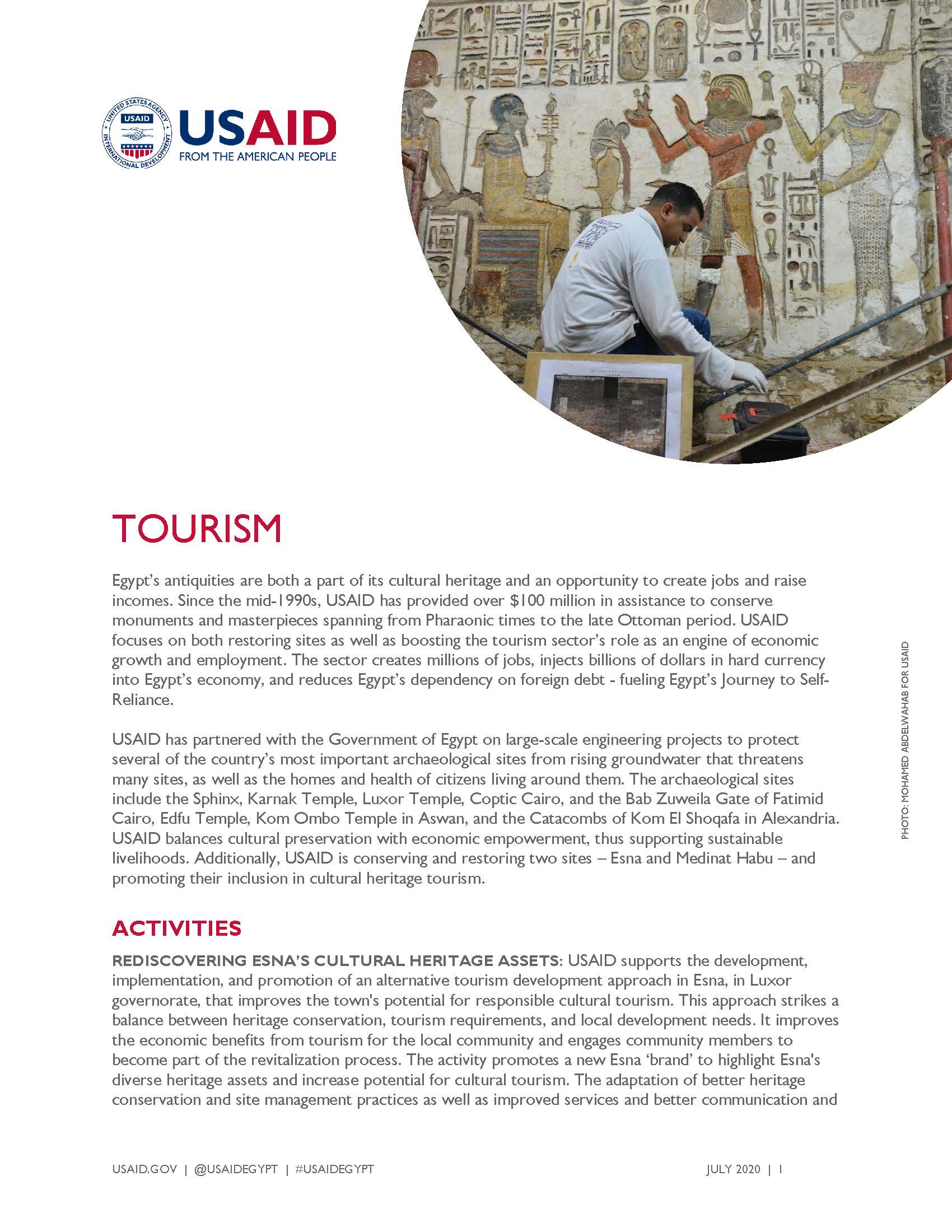Speeches Shim

Overview
Egypt’s antiquities are both a part of its cultural heritage and an opportunity to create jobs and raise incomes. Since the mid-1990s, USAID has provided over $100 million in assistance to conserve monuments and masterpieces spanning from Pharaonic times to the late Ottoman period. USAID focuses on both restoring sites as well as boosting the tourism sector’s role as an engine of economic growth and employment. The sector creates millions of jobs, injects billions of dollars in hard currency into Egypt’s economy, and reduces Egypt’s dependency on foreign debt - fueling Egypt’s Journey to Self-Reliance.
USAID has partnered with the Government of Egypt on large-scale engineering projects to protect several of the country’s most important archaeological sites from rising groundwater that threatens many sites, as well as the homes and health of citizens living around them. The archaeological sites include the Sphinx, Karnak Temple, Luxor Temple, Coptic Cairo, and the Bab Zuweila Gate of Fatimid Cairo, Edfu Temple, Kom Ombo Temple in Aswan, and the Catacombs of Kom El Shoqafa in Alexandria. USAID balances cultural preservation with economic empowerment, thus supporting sustainable livelihoods. Additionally, USAID is conserving and restoring two sites – Esna and Medinat Habu – and promoting their inclusion in cultural heritage tourism.
USAID/Egypt Fact Sheet: Tourism ![]() (pdf - 397k)
(pdf - 397k)
Current Activities
REDISCOVERING ESNA’S CULTURAL HERITAGE ASSETS: USAID supports the development, implementation, and promotion of an alternative tourism development approach in Esna, in Luxor governorate, that improves the town's potential for responsible cultural tourism. This approach strikes a balance between heritage conservation, tourism requirements, and local development needs. It improves the economic benefits from tourism for the local community and engages community members to become part of the revitalization process. The activity promotes a new Esna ‘brand’ to highlight Esna's diverse heritage assets and increase potential for cultural tourism. The adaptation of better heritage conservation and site management practices as well as improved services and better communication and interpretation of Esna’s cultural heritage assets enhances the visitor experience. This generates new job opportunities, increases revenues, and increases economic benefits for the community. Implementing Partner: Takween Integrated Community Development; Life of Project: October 2016 – November 2020; Total Estimated Cost: $2.5 million; Governorate: Luxor
MEDINAT HABU AS OPEN-AIR MUSEUM: Medinat Habu, located on the west bank of Luxor (ancient Thebes), is best known for its well-preserved mortuary temple of Ramesses III (reigned ca. 1186 to 1156 B.C.) and also houses archaeological monuments spanning the period 2100 B.C. to 900 A.D. USAID supports restoration of the archaeologically rich but neglected western sector of Medinat Habu to increase tourist interest in the temple complex. Site improvements include a walking path and an open-air museum. Implementing Partner: University of Chicago Oriental Institute - Chicago House; Life of Project: October 2015 – September 2023; Total Estimated Cost: $6 million; Governorate: Luxor
GROUNDWATER LOWERING: Since 2000, USAID, at the request of and in collaboration with the Government of Egypt, has completed several large-scale engineering projects to protect several of the country’s most important archaeological sites from rising groundwater. USAID’s engineering partners identify the sources and quantity of groundwater flowing toward the sites and then design and construct systems that will protect the antiquities from the groundwater. USAID also brings in archaeological experts to work in partnership with Egypt’s Ministry of Tourism and Antiquities to properly preserve and document archaeological information and objects discovered during system design and construction. Recently, supported and contributed to the engineering design, construction and construction management services for groundwater lowering systems at Edfu Temple and Kom Ombo Temple near Aswan and the Catacombs of Kom El Shoqafa near Alexandria. Currently, we are supporting the operation, maintenance, and training of the Ministry's staff on operation and maintenance for one year. Implementing Partner (construction): National Organization for Potable Water and Sanitary Drainage (NOPWASD); Life of Project: August 2017 – June 2020; Total Estimated Cost: LE 147 million; Governorates: Alexandria and Aswan



Comment
Make a general inquiry or suggest an improvement.